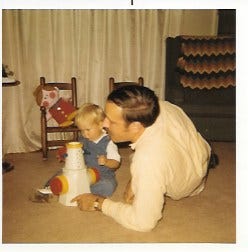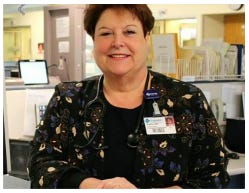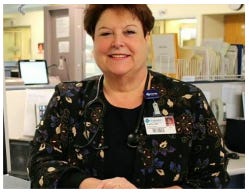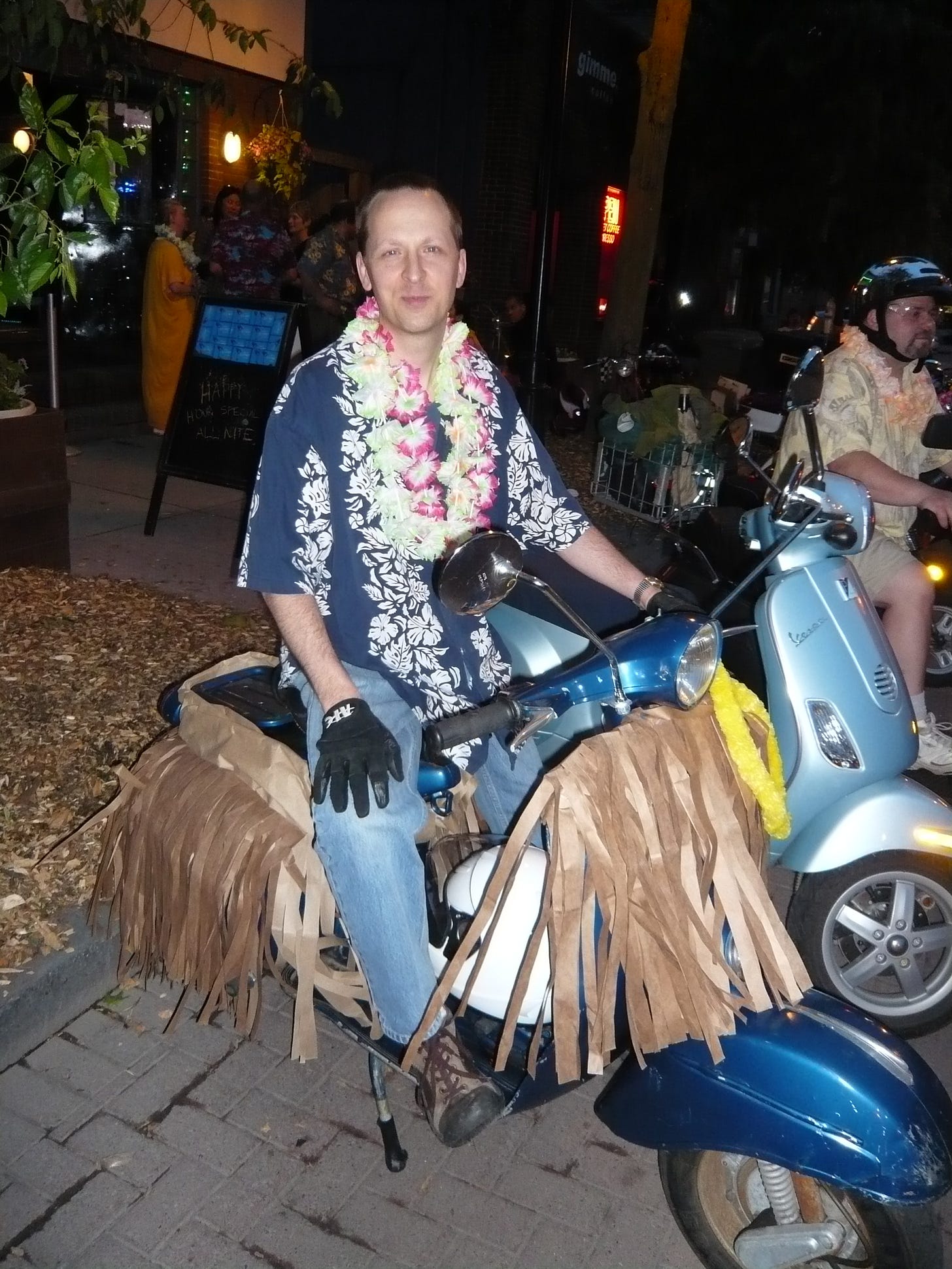
Pushing buttons
PAST
Those of you who have read my Substack since the beginning, may recall the story about me poking a stick in the yellow jackets nest. There were other more benign, but related events of me probing and testing the world and its inhabitants. In fact, there are many memorable non-events. Did escalators scare you as a child? Heck, did the bathtub drain scare you? I know it scared at least some of us, because Mr Rogers sang a song about it. “You Can Never Go Down the Drain.” Hah!
I wish he’d done a song about the sharp teeth of the escalators, but at least he did produce a sweet episode about up and down which included escalators. In my little kid brain, it seemed absolutely possible that my sneakers could get caught in moving stairs, pulled into them and mashed into bits! Every Christmas my wife and I watch Elf, with Will Ferrel, and I think the scene with him doing that fearful split on the ascending escalators is brilliant.
The escalators in our local Sears Roebuck were particularly captivating— and terrifying— to me as a child. One year around Christmas I saw the big red button at the base of the handle belt, with letters underneath that said STOP. Without much thought and zero premeditation I leaned over and pushed it. Then, those mashing metal teeth stopped. The silence was eerie. I felt this sensation of power over my destiny, that little old me could stop this enormous machine with the push of a button. I looked around and saw no one. Realizing that I maybe should not have done that, I hastily made my getaway. I ran down the now still stairway which released a hollow clunk with each step. I caught up with my mom and we left without further incident— until twelve years later….
SLIGHTLY MORE RECENT PAST
As a teenager, I lived with my Nana and Pop pop in the tiny village of Parkerford, PA, in a little house, with a corn field in our backyard. My high school was named after the former Supreme Court Justice Owen J Roberts. We had an active chapter of the Future Farmers of America (FFA), and in the Fall and Spring seasons, when the windows of our classrooms were open, the sweet smell of cow manure being spread on the fields filled the air. There was also a farm store across the street from our school where many of us headed for snacks before catching the late bus home.
Trips into the vast city of Philadelphia were therefore a very big deal. My friend Larami, now an esteemed Interventional Neurologist in the University of Pennsylvania health care system, loved, loved, loved to initate those trips. We would drive to Paoli and catch the R5 SEPTA Regional Rail line into Center City Philadelphia. Before Christmas of 1986, Larami, his brother Monk , Chris and I made one such trip. Larami’s inspirations and infatuations of the moment circumscribed our plans. So, first we went for the buffet at Salad Alley in the Bourse Building for lunch. Then we headed to The Galleries for some shopping. This was an urban mall with at leat four levels opening onto a vast interior, and it…was…packed. We entered on the street level and approached the escalator. Without premeditation, and with an impulsivity that I cannot explain or defend, my eyes landed on the big red STOP button below the escalator railing, right where it had been all those years ago. I leaned over, and pushed it.
Unlike the Sears escalator of my boyhood however, this one was packed with people, who all gave a little forward and backward bobble as the escalator suddenly stopped.I was just ahead of my friends, and when they saw what I had done, they looked at me in surprise, perhaps amusement, and then concern. Within moments I was surrounded by at least six very large security officers. The Gallery didn’t mess around with security. Gang activity and drive by shootings were on the rise, and off-duty police officers could pick up some nice extra pay during Christmas. These security officers were at least twice as tall and three times as wide as me.
Their radios crackled. Ccckkkk “Level one escalator has stopped. Nobody appears to be hurt.” Ccccckkkkkk “We have a white male teen in custody.” Cccckkkkk. Before they even bothered asking me what I had done, they turned to my friends and asked “Is he with you?” They all shook their heads no and slowly backed away. F#@*?rs!! Obviously we were together. Then the guards all turned back to me. I remember looking up and seeing about five hundred people lining the railings of the different levels to see what was gong to happen to this crazy little white boy.
Time passed. I was contemplating what I would tell my Pop pop when I called from the city jail. “You what!?!” More radio crackling. Cccckkkkk “Yes sir. Yes sir. No sir. I don’t think so sir. Roger that sir.” Cccccckkkkk. One of the very big men looked at me and said “We’re going to have to ask you and your friends to leave and not return to the premises.” Really? That’s it? No jail? No report? They escorted me and my disavowing friends to the nearest exit and stood inside the doors to make sure we went on our way.
Well, dear reader, I’d be lying if I said that was the last button I ever pushed. Which brings me to the present moment.
PRESENT
Once a month I meet with wise man who I’ll call my business guru and emotional mentor. His name is Geep, and he likes to tell me instructive stories which I don’t always enjoy. One thing which he has told me more times than I can remember is, “Scott, try not to piss people off by accident.” Well, last week on the FLCCC Webinar, I think I pissed off a lot of women who are keen on using collagen to soften their wrinkles, harden their nails, and keep their hair from falling out. Frankly, I’m lucky to be alive!
It was great fun being on the weekly webinar with Dr Marik. During the webinar, when I shared my observations that collagen appeared to be provoking platelet aggregation and activaton in my patients, it didn’t seem like a big deal. Perhaps what I forgot to say was what all of the Tarot readers my wife watches on You Tube say: “The following is for entertainment purposes only.” When Pierre texts me on Saturday and writes “I known it’s your one day off, but….”, what follows is never good. It seems that I stirred up a shit storm with those observations and the FLCCC was trying to manage it.
To differentiate the players, the FLCCC is a rigorously science-based organization, and Dr Marik is the guardian of that galaxy. If there aren’t studies to back an assertion, or a heck of a lot of clinical observeration, it isn’t going to make it onto the FLCCC protocols. On the other hand, the Leading Edge Clinic is our private telemedicine practice, and as diligent clinicians, if we see signals that a therapy is harming our patients, we won’t wait until a study comes out to warn them. For example, Dr Peter McCullough asserted months ago that shedding wasn’t real, because he couldn’t find any studies which supported the ideas. The rest is history, as we began acting based upon our clinical observations re: shedding almost a year ago, instead of waiting for a study which may never happen to confirm it. Now I can’t count how many interviews Pierre has given on the topic!
Back to collagen. I understand that it could be upsetting to hear me assert that the supplement your functional medicine physician / chiropractor / naturopath / yoga instructor (not kidding here) recommended to you may be exacerbating coaguloptahy in your body. All you were trying to do was not look so damn old. As John Stewart recently said during his second episode of The Daily Show in nine years: “I have sinned against you. I’m sorry. It was never my intention to say out loud what I saw with my eyes and then brain. I can do better.” Instead of Stewart’s ironic statement that “democracy dies in discussion”, I could say “science dies in discussion.”
Forgive me for my habit of risk benefit analysis. Not only are there no studies supporting my position on collagen and clotting, there is even one research paper from 2004 which may contradict it. Of course that paper was written before space aliens zapped us with a bioweapon made in the distant galaxy of Wuhan and deranged our bodies to such a degree that most of our pre-exisitng lab studies, radiologic tools, and diagnostic approaches have been nearly useless. It’s also worth mentioning that the collagen market is estimated at 5.1 billion USD in 2023 and is projected to reach 7.4 Billion USD by 2030, at a compound annual growth rate (CAGR) of 5.3% from 2023 to 2030. This is a minor matter though, because I’m sure that the good people of supplement sales only have our best interests at heart. It also doesn’t really matter that there really isn’t substantial evidence to support the benefit of collagen in attaining beautiful skin, full bodied hair, strong nails. We also need not be troubled by the lack of any standardization or FDA regulation of these collagen products which are ingested in good faith by so many.
Did you know that collagen is a waste product? It’s made from the leftover connective tissue of fish, pigs and cows (unless you’re getting the vegan version). I love waste products as much as the next guy. We have had a worm composter in our basement for years. I love making them smile with a bruised avocado half. Their excrement feeds the beautiful lives of our houseplants and garden. Our cat litter is made from the refuse of lumber mills, pine wood sawdust. It smells great and we can compost it. Even yummy apple cider is a refuse product made from the seconds. The thing is that besides apple cider, I can’t think of another refuse product which I would ingest, let alone pay big money to consume.
According to historian Roxeanne Dunbar Ortiz, at its peak, the Native American population of North American reached 450 million people. They lived on this land for millenia. Uniformly, they used every part of the animals and fish which they hunted and harvested. Tendons and sinews were used to make bowstrings and thread. Cartilage and hooves could be ground into glue. But, they didn’t routinely ingest connective tissue, the basis of animal collagen. Why not? Did they intuitively understand something which escapes us in the present moment?
What follows is a case series of patients in whom I think that collagen played a role in their pathology and in most cases, may have set them up for their original injury, and often exacerbated coagulopathy. You’ll see references to Vitamin K2 as well. I won’t entertain questions about that until I’ve been able to explain my observations and strategy in next weeks’ Substack. I’ve spent a ridiculous amount of time on this project in the last week. Because the number of cases is fifteen and growing, I’m going to divide this up between today and next week. As a disclaimer, the following is for entertainment purposes only, and it is not to be misconstrued as frontline clinical insight or evidence from an expert in the field. ; )
Patient 0
18yo female x2 mRNA Pfizer vaccine injury within two weeks of second shot. Family unvaccinated. First visit 2/23. Previously healthy, s/p tonsillectomy, competitive athlete. Intake reports fatigue, shortness of breath, chest pain, joint pain, dizziness when standing, fast or pounding heart rate (HR), worsened symptoms after activity. Blurred vision when exercising, dizzy, light headed, nauseous, swollen ankles, chest and back pain, heavy weight on chest, sharp pains on left side of chest, trouble breathing, high heart rate and high diastolic blood pressure when exercising. 2/23 live blood analysis showed RBC aggregates, Rouleaux formations, poikilocytes, echinocytes, schisocytes, acanthocytes, and platelet aggregation. Initiated Aspirin, Eliquis, IVM and NAC Augmentata 3/23. By 5/23 had seen tremendous improvement in leg movement and strength,adjusting fine motor movements, working with an unvaccinated personal trainer. 4 of 4 microclotting, severe and widespread in study 10/23. It was surprising that her level was still this high despite five months of anticoagulation therapy. 11/23 visit revealed that several months ago she had tried collagen for 3-4 days. During that time, leg pain and weakness which was associated with her microclotting became much worse. Spike ab not available due to location and lack of access to a Lab Corp facility.
Batch ADRs Deaths Disabilities Life Threatening Illnesses
FN7924 No data
FM2952 2
Patient 1
20yo female, x2 mRNA Pfizer vaccine injury. First seen 2/24. Previously healthy with no surgical history. Spouse is not vaccinated, and shedding exposure is primarily from her boosted mother. Intake reports fatigue, shortness of breath, fast or pounding heart rate, possible enlarged atrium, low blood pressure. Interview reveals strong signal of MCAS with childhood migraines and many food sensitivities. Also had pediatric GI issues which continue into the present moment. Developed increased anxiety post-vaccine and started Lamotrigine, currently weaning. Fainted following a competitive sports event in July 2023. Started collagen on and off for hair/skin/bones in August 2023. Started iron supplementation due to fatigue about December 2023. DC’d oral birth control December 2023. Had a second fainting episode at work in January of 2024. Developed chest pain, dyspnea and fatigue. ED visit showed abnormal ECG, and follow up cardiac echocardiogram was abnormal with possible atrial enlargement, further evaluation pending. Labs for spike ab, D-dimer, neurotransmitters (urine) pending.
Patient 2
55yo female, post-acute sequelae of COVID (PASC), unvaccinated. Spouse is vaccinated. First seen 1/24. Hx TBI, cervical cancer, asthma, hypothyroidism S/p incarcerated inguinal hernia, hysterectomy, oophorectomy, cholecystectomy, appendectomy, tonsillectomy, adenoidectomy, right knee replacement x3 in 18 months. Intake reports fatigue, brain fog, memory problems, shortness of breath, chest pain, joint pain, dizziness when standing, symptoms worsening after activity, distant Hx of PE. Pain in the spleen, increased CRP values, inflammation, severe constipation. COVID in late 2019, early 2020, and early November 2023. Strong signal of MCAS,with very narrow range of foods she can eat. Taking collagen and Vitamin K2. Guided to DC both.
Spike ab 2345 U/mL
>>D-dimer 0.87 mg/L FEU
PAI-1 4G/4G polymorphism (denotes high risk of developing venous thromboembolism)
ADAMTS13 >100%
ADAMTS13 Ab 3 U/mL
Factor VIII Activity 70%
Serotonin, serum 76 ng/mL
Patient 3
68 year old male with PASC, unvaccinated. Initial symptoms in 2/23 were sinus congestion, impact on right ear hearing, new diagnosis of asthma, and wet end-expiratory breath sounds. Raynaud’s began before COVID and receiving monoclonal antibodies in the Winter of 2020. Post-COVID, developed an arrtyhmia and worsening GERD. Has had allergies his whole life. Most recently, feeling well overall, but has intermittent muscular trouble with focal pain in one leg and bilateral leg fatigue after exertion.
Spike ab level: 3564 U/mL in 2/23, down to 157 U/mL 5/23, up to 2172 U/mL 12/20/23 following travel and shedding exposure. Microclotting score 3 of 4 moderate in 8/23, drop to only 2.75 of 4 in 1/24. Question arose re: why there was such a small drop in microclotting after five months with use of Aspirin, IVM, Serrapeptase, Nattokinase, Flavay, Baobab, NAC Augmentata. Scrutiny of medication reconciliationg (med rec) revealed that he was taking collagen protein peptides as a powder along with Vitamin K2 in an MVI. The collagen had been recommended by a functional medicine physician for muscle soreness several years ago. Collagen and Vitamin K2 DC’d.
Patient 4
54 y.o. female x2 mRNA Pfizer with vaccine injury. First seen for acute COVID in 9/22. Seen in follow up 10/22 for persistent enlarged, painful lymph nodes, then 11/22 for vaccine injury. Had been on a proton pump inhibitor (PPI) when she was originally infected with COVID and vaccinated, which likely contributed to her injury. She stopped this in early 11/22. Lymph nodes in bilateral axillae continued to be painful, and she noted outbreak of Herpes Simplex Virus (HSV) lesions on her lips. Reporting persistent heel pain, GERD. In 12/22, had extended menses of twenty days, which stopped 4-5 days after initiation of high dose IVM. We then dropped the dose due to emerging photosensitivity. Nattokinase was started. Lost weight, followed a lower histamine diet, had COVID again around Memorial Day 2023. Menses began to be prolonged again, following acute COVID and extensive travel for work. Was experiencing increased fatigue. Started sipping Baobab in 7/23 as one of our twenty pilot study participants. Spike ab level has consistently been >25,000 U/mL since first testing in 7/23, and with repeat testing in 9/23 and 1/24. Microclotting score was 3 out of 4, moderate 8/23.
Batch ADRs Deaths Disabilities Life Threatening Illnesses
EW0177 1458 6 12 18
Fasting glucose decreased from 99 to 96 over the first month of sipping Baobab. Menses stabilized. Began anticoagulation with Aspirin, Eliquis and Plavix in 9/23, along with IVM, NAC Augmentata, Nattokinase. In 10/23 saw decreased dyspnea with exertion, but injured left shoulder while lifting a heavy object. At this time she stopped taking collagen, and began taking colostrum to help heal her gut. I was not yet suspecting the role of collagen in provoking coagulopathy. Use of the Arc Microtech helped minimize bruising and bleeding concerns on anticoagulation. Despite stress of family health issues, job changes, and her own health challenges, she was doing well during this period. Flavay was started in 11/23, and we fine-tuned treatment for MCAS by adding Antronex, a natural antihistamine from Standard Process. She had an acute viral illness around Thanksgiving following exposure to many family members who were acutely ill. We initiated peptide BPC-157 for gut healing and ProTandim for emerging cognitive concerns. Chronic connective tissue concerns began to yield, with less shoulder and heel pain, improved appetite, resolution of skin issues. She had backed off the Baobab use for two months. Menses became elongated again, and she was having sleep disturbances.
Patient 5
49 yo female, PASC, unvaccinated. Husband not vaccinated. Hx migraines, MTHFR gene mutation, S/p ACL reconstruction. Previous COVID-19 infection by testing or presumptive by symptoms, January 2022 and December 2022. Onset ~ four weeks after initial COVID infection. Intake reports brain fog, memory problems, anxiety and depression. Mother, sister’s husband and all of their close friends have been vaccinated. Was around them after sick first time. Unvaccinated daughter and son attend schools around many vaccinated students. Husband works around many vaccinated individuals. Shedding is an active dynamic and ongoing consideration in her care. 2/23 labs showed spike ab 844 U/mL and slight elevation of D-Dimer at 0.51 mg/L FEU, a late sign of microclotting. 3/23 labs reflected reactivation of EBV with early antigen level of 10.4 U/mL. 8/23 microclotting study showed stage/grade 4 of 4, widespread and significant. Patient and her husband asserted that there was a mistake in the labs and this was another patient’s blood. When she went to the lab for another draw, the phlebotomist couldn’t draw her blood, because it kept clotting. They then agreed this was in fact her blood, and wished to initiate treatment. Started triple anticoagulation with Aspirin, Eliquis and Plavix as well as IVM, LDN, NAC Augmentata, Nattokinase. Repeat microclotting study 11/23 showed reduction to 2.5 of 4, mild. Patient felt 95% recovered. In 12/23 and 1/24 visits, patient was exhibiting some relapse of symptoms secondary to shedding, but still doing well overall. In 1/24 visit she remarked, “Two weeks ago I was feeling really good. I haven’t felt that good since 2022.” Then her menses came, and she experienced a return of severe migraine. At the end of the visit, in response to questioning from this provider, she reported that she had started taking collagen a few weeks ago. Collagen DC’d after this visit. End of 2/24 patient reports that she is feeling much better, and was able to go for a one mile walk.
Patient 6
39 yo female, x2 mRNA Pfizer vaccine injury. Increased fatigue over 2021 following vaccination. Previous COVID-19 infection by testing or presumptive by symptoms, December 2021. Husband vaccinated, works in health care. Hx chronic fatigue syndrome, headaches, migraines. S/p no surgeries declared. Intake reports fatigue, brain fog, memory problems, dizziness when standing, chest pain, tachycardia, headaches, depression or anxiety, worsened symptoms after activity, new onset daily headaches/ migraines, nausea. One night she didn’t take her Aspirin, and the next day she had a severe headache. “This is like dementia. I would open the fridge ten times and not knowing what I was looking for.” During discussion late 2023, patient reported that she would use collagen supplementation in a liquid form regularly in the years before she became sick with COVID. 2/23, spike ab was 9814 U/mL. 8/23 study showed 4 of 4 microclotting, severe and widespread.
Batch ADRs Deaths Disabilities Life Threatening Illnesses
EL0140 1243 52 20 24
EJ686 8
Patient 7
61yo female, PASC, unvaccinated. First seen 4/22. Hx of hypertension (HTN), s/p tubal ligation and foot surgery. Three previous COVID-19 infections by testing or presumptive by symptoms, 11/2020 around Thanksgiving, and again 1/21, 7/22. Onset 3/21, with lost of taste and smell, hypertension, fatigue, brain fog and memory problems, with worse symptoms after exertion. Stress from a busy work week also exacerbates symptoms. Eating a low histmaine diet. Completed BioAnalytics cytokine panel with Dr Patterson, started on Maraviroc for one month and most of symptoms resolved, although CCL4 remained elevated. Excercise with HR > 100 provokes post-exertional malaise, and allergy symptoms with increased phlegm production and watering eyes for several days afterwards, at worst with vertigo, nausea and vomiting. Low dose Dexamethasone was helfpul, as well as short-term, low dose Fluvoxamine. HR improved and tapered off a beta blocker. High dose IVM didn’t resolve loss of taste and smell; we then tried Vascepa, again without benefit. Spike ab was 2497 U/mL. During 2/23 visit, secondary to shedding from spouse traveling to a trade show, going to the gym, and being around vax/boosted people, saw increase in sympotm burden. Experiencing eye twitching, vertigo, heat on back of her neck, returning fatigue, and increasing BP. Initiated Arc Microtech after 7/23 visit. At 11/23 visit, vertigo resolved, drop of spike ab to 940 U/mL continuing with low intensity exercise, modulating MCAS with antihistamines, and eating lower histamine diet. Aspirin and Flavay initiated for presumed microclotting. In successive visit Antronex and Ketotifen for MCAS initiated, and Oxytocin for taste/smell. Completed microclotting study 1/24, which showed 2.5 of 4, mild. During that visit, in response to my questions, she reported that she had been taking collagen 1 Tablespoon daily for years. Collagen DC’d. Within about two weeks of stopping the collagen, and initiating low-dose Nicotine patch, her taste and smell, which had remained elusively absent for more than two years, began to return, albeit inconsistently.
P.S.. Thank you to Dr Ronald Epner for your generous financial support as the first reader to become a Founder. And thank you to each of the individuals who has chosen to support this work by becoming paid subscribers.
P.S.S. If you know someone in Wyoming or West Virginia who would enjoy reading Lightning Bug, please share. Those are the only two states from which I don’t have subscribers. I’m offering a free lifetime subscription to the first person from each of those states to become a reader.
P.S.S.S. I tried to send out a brief survey re: collagen and it didn’t work out of the box, so I deleted it. I’ll try again after learning more about this tool.









